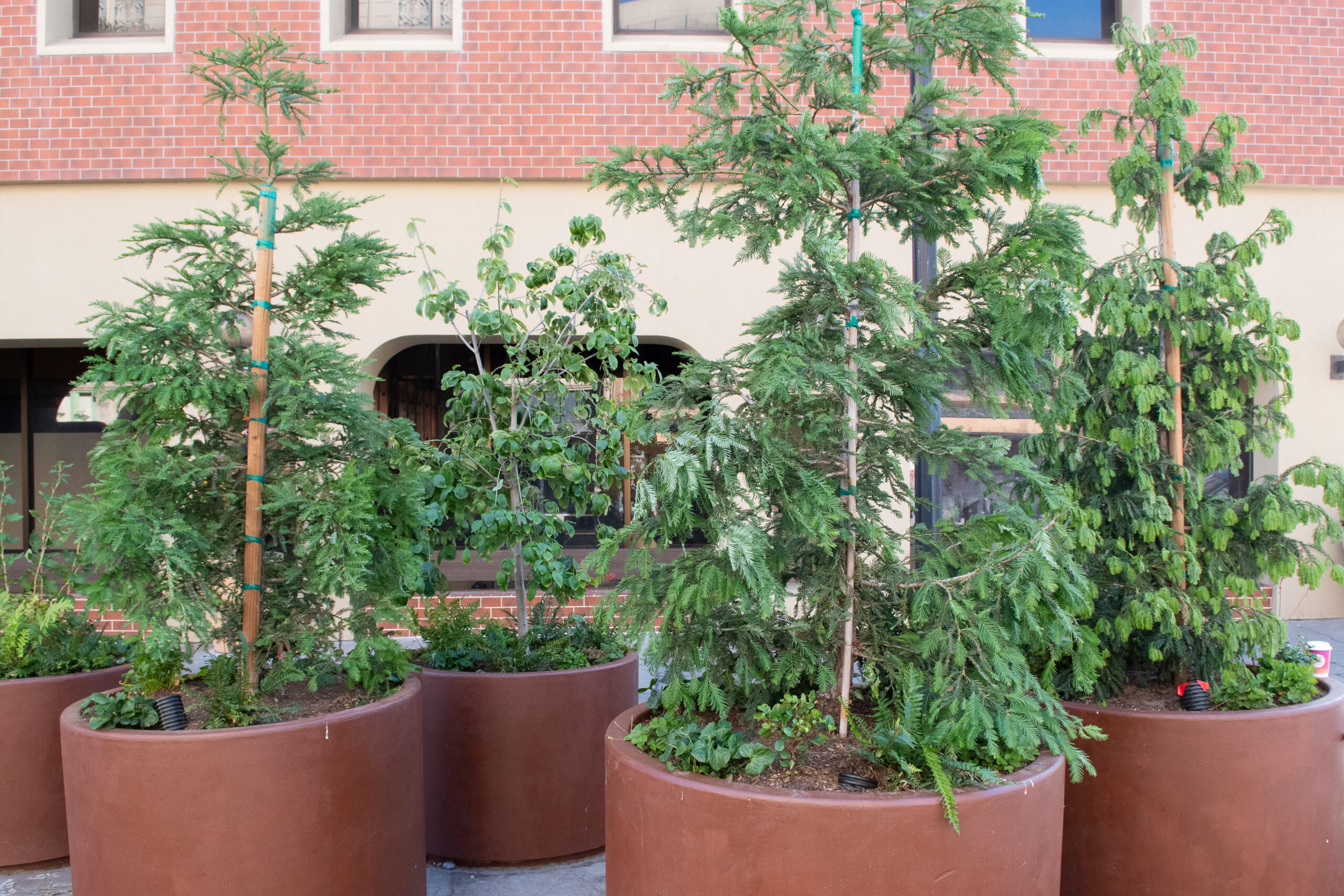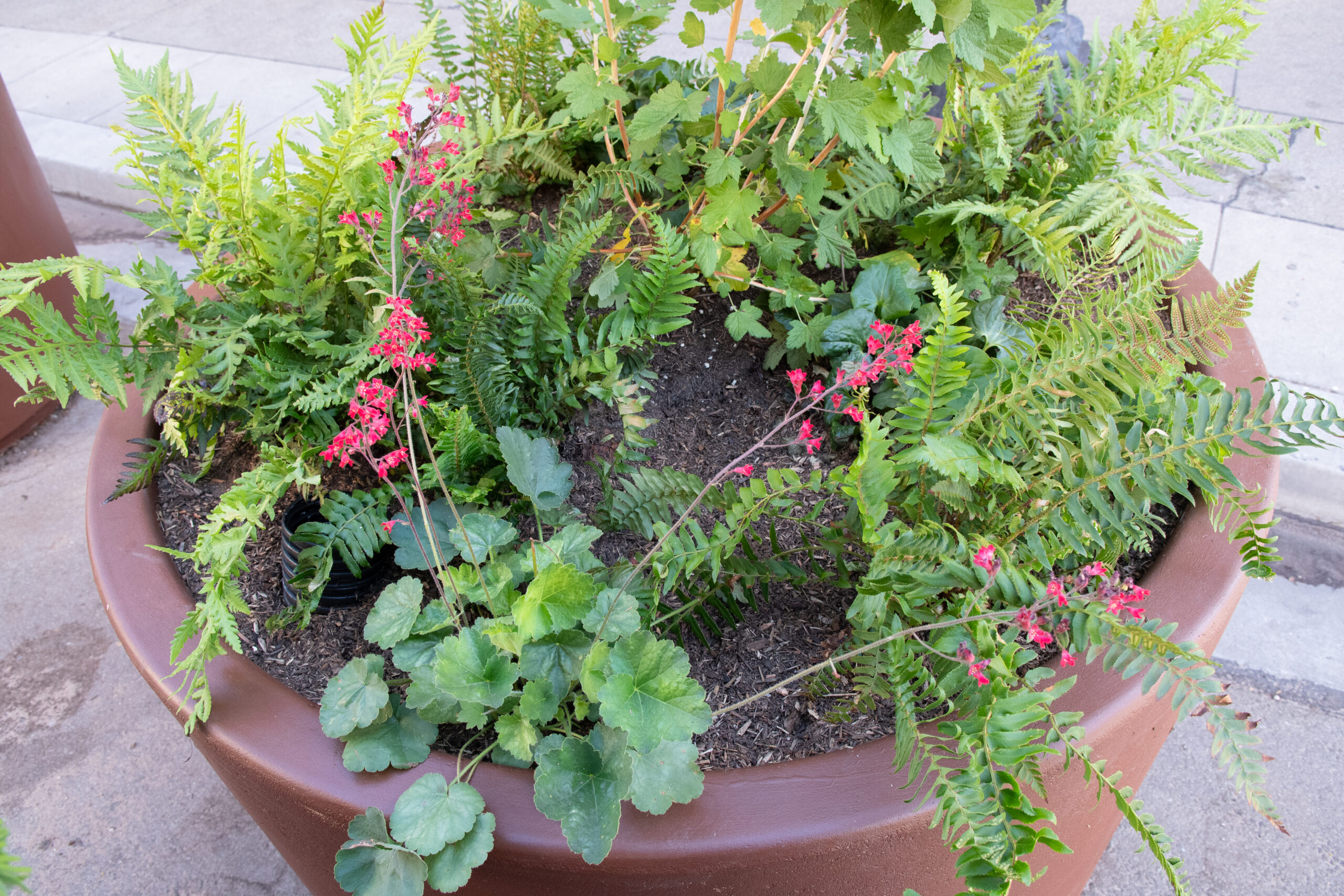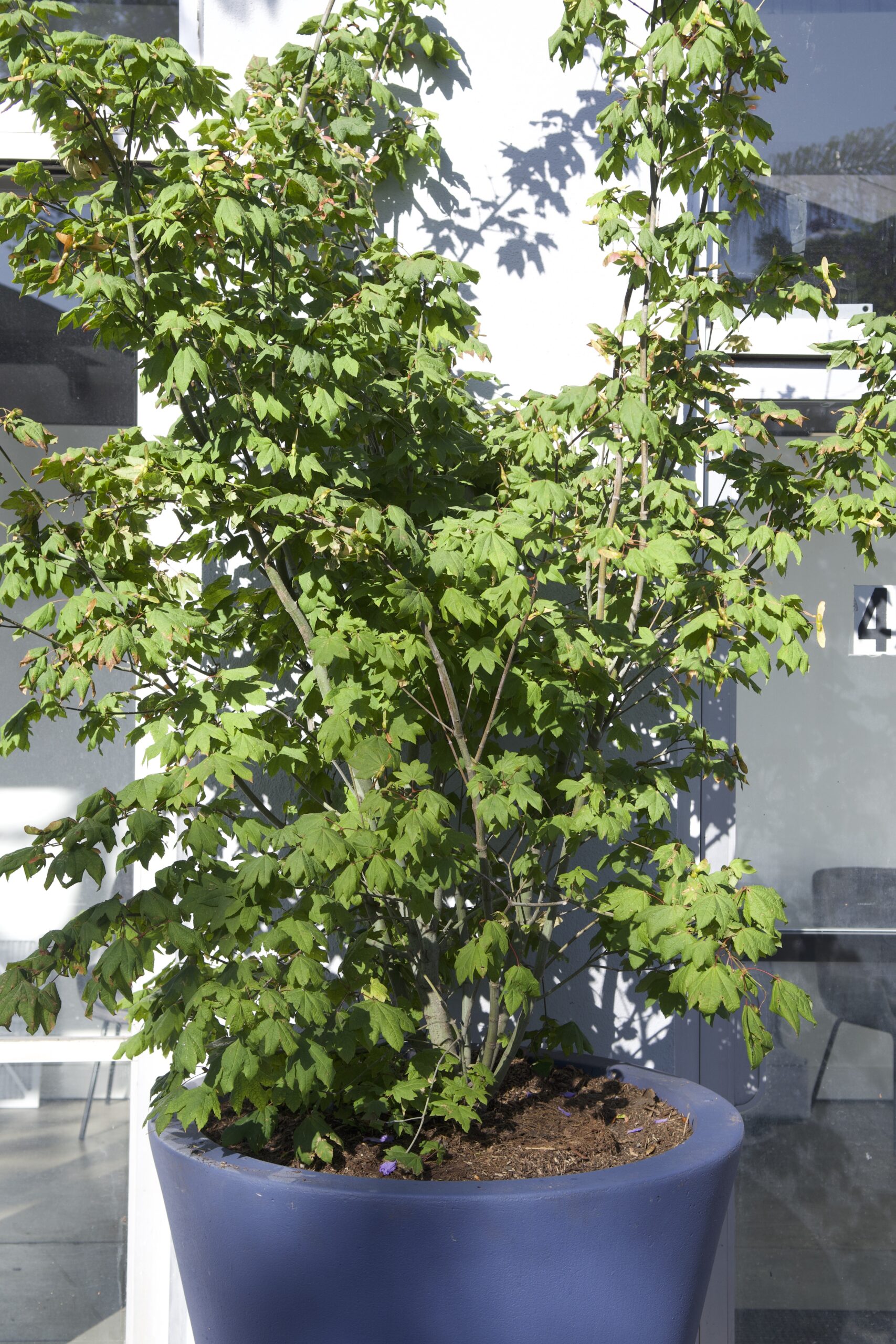SoFA Urban Garden
Located at 320 and 431 South First Street
Redwood forests are among the oldest in the world. They are also home to the tallest tree in the world and California’s state tree, the Coastal Redwood. Although they take up plenty of vertical space, the forest’s understory is also full of wonderful plants, housing a diverse variety of ferns and redwood sorrels that create a prehistoric atmosphere. The redwoods in the Bay Area were used to construct many early buildings in their surrounding cities and played an integral part in the Bay Area’s development in the 180’s. In downtown San Jose, one coastal redwood can be found in Plaza de Cesar Chavez.
Redwood Forest
Pacific Dogwood
Scientific Name: Cornus nuttallii
Native Habitat: Pacific coast range from Canada to Central California. Usually found at the edge of forests.
Pacific Dogwoods are small to medium sized trees that produce bright 6-petal flowers that support many bird and insect pollinators. Their seeds are also eaten by bears and beavers in wild areas. It requires low moisture and is great to use in any bird garden.
Western Wild Ginger
Scientific Name: Asarum caudatum
Native Habitat: Rich moist forests from British Columbia to California
Western Wild Ginger has distinct features that set it apart from many plants. The plant clones itself underground to reproduce, but can also make seeds when the flowers are pollinated. The seeds are dispersed by ants, which are attracted to the seeds' fatty layer. Although the plant can reproduce with seeds, it remains a rare occurrence.
Catalina Perfume
Scientific Name: Ribes viburnifolium
Native Habitat: Found in abundance in Santa Catalina Islands and coast of north Baja California.
The Catalina Perfume is a shrub known for its fragrance, and originates from the Santa Catalina Islands off the coast of Los Angeles. The plant’s fragrance comes from leaf glands that secrete a citrus scented sap, and is heightened during the rain. Hummingbirds and insects are also attracted to its purple and red flowers, while insects and small animals eat its fruits.
Western Sword Fern
Scientific Name: Polystichum munitum
Native Habitat: Along the Pacific coast from southeast Alaska to southern California.
The Western Sword Fern is one of the most common ferns in western North America, and is often seen living in the understories of coniferous woodlands.
Coastal Redwood
Scientific Name: Sequoia sempervirens
Native Habitat: Coasts of California with the southernmost border at Monterey County.
The Coastal Redwood is one of the most iconic trees in California, and became the state’s official tree in 1937. Many of the oldest and tallest trees in the world are Coastal Redwood trees. During California’s early development in the 1850’s, redwood trees were a valuable resource of lumber until the species were nearly exhausted. Since then, a statewide replanting effort has restored many lumbered areas into Coastal Redwood ecosystems. Even downtown San Jose has a few!

Flowering Currant
Scientific Name: Ribes sanguineum ‘Claremont’
Native Habitat: Found in western coastal North America from Canada to southern California.
The Pink Flowering Currant produces bright pink flowers that attract hummingbirds, and dark fruits that attract other birds. The shrub is also a host for several butterfly species, making it a good choice for butterfly gardens.
Western Wild Ginger
Scientific Name: Asarum caudatum
Native Habitat: Rich moist forests from British Columbia to California
Western Wild Ginger has distinct features that set it apart from many plants. The plant clones itself underground to reproduce, but can also make seeds when the flowers are pollinated. The seeds are dispersed by ants, which are attracted to the seeds' fatty layer. Although the plant can reproduce with seeds, it remains a rare occurrence.
Western Sword Fern
Scientific Name: Polystichum munitum
Native Habitat: Along the Pacific coast from southeast Alaska to southern California.
The Western Sword Fern is one of the most common ferns in western North America, and is often seen living in the understories of coniferous woodlands.
Coral Bells
Scientific Name: Heuchera sanguinea
Native Habitat: Southwest United States from Arizona to Northern Mexico. Prefers living in moist and shaded foothill woodlands.
Coral Bells are appreciated for their round heart shaped leaves that grow in clumps, as well as their bright red flowers that grow from a flowering stem. Bees and hummingbirds are attracted to the flowers. The plant is also used as groundcover in gardens.
Giant Chain Fern
Scientific Name: Woodwardia fimbriata
Native Habitat: Forests of west coast North America.
The Giant Chain Fern is the largest fern in North America. Its fronds can reach up to eight feet in length, and prefers to live in moist forests and woodlands. This fern is also widely used in landscaping and habitat restoration.

Vine Maple
Scientific Name: Acer circinatum
Native Habitat: Found in coastal forests from British Columbia to Northern California.
The Vine Maple grows as a large shrub, typically in the understory of much taller trees like the Coastal Redwood. Its leaves turn into a beautiful red color during the fall season, and its seeds have a distinct wing-like shape that allow them to be carried in the wind.

Coastal Redwood
Scientific Name: Sequoia sempervirens
Native Habitat: Coasts of California with the southernmost border at Monterey County.
The Coastal Redwood is one of the most iconic trees in California, and became the state’s official tree in 1937. Many of the oldest and tallest trees in the world are Coastal Redwood trees. During California’s early development in the 1850’s, redwood trees were a valuable resource of lumber until the species were nearly exhausted. Since then, a statewide replanting effort has restored many lumbered areas into Coastal Redwood ecosystems. Even downtown San Jose has a few!
Western Sword Fern
Scientific Name: Polystichum munitum
Native Habitat: Along the Pacific coast from southeast Alaska to southern California
The Western Sword Fern is one of the most common ferns in western North America, and is often seen living in the understories of coniferous woodlands.
Evergreen Currant
Scientific Name: Ribes viburnifolium
Native Habitat: Found in abundance in Santa Catalina Islands and coast of north Baja California
The Catalina Perfume is a shrub known for its fragrance, and originates from the Santa Catalina Islands off the coast of Los Angeles. The plant’s fragrance comes from leaf glands that secrete a citrus scented sap, and is heightened during the rain. Hummingbirds and insects are also attracted to its purple and red flowers, while insects and small animals eat its fruits.
Coral Bells
Scientific Name: Heuchera sanguinea
Native Habitat: Southwest United States from Arizona to Northern Mexico. Prefers living in moist and shaded foothill woodlands.
Coral Bells are appreciated for their round heart shaped leaves that grow in clumps, as well as their bright red flowers that grow from a flowering stem. Bees and hummingbirds are attracted to the flowers. The plant is also used as groundcover in gardens.
Pacific Dogwood
Scientific Name: Cornus nuttallii
Native Habitat: Pacific coast range from Canada to Central California. Usually found at the edge of forests.
Pacific Dogwoods are small to medium sized trees that produce bright 6-petal flowers that support many bird and insect pollinators. Their seeds are also eaten by bears and beavers in wild areas. It requires low moisture and is great to use in any bird garden.
Giant Chain Fern
Scientific Name: Woodwardia fimbriata
Native Habitat: Forests of west coast North America
The Giant Chain Fern is the largest fern in North America. Its fronds can reach up to eight feet in length, and prefers to live in moist forests and woodlands. This fern is also widely used in landscaping and habitat restoration.
Vine Maple
Scientific Name: Acer circinatum
Native Habitat: Found in coastal forests from British Columbia to Northern California.
The Vine Maple grows as a large shrub, typically in the understory of much taller trees like the Coastal Redwood. Its leaves turn into a beautiful red color during the fall season, and its seeds have a distinct wing-like shape that allow them to be carried in the wind.
Western Wild Ginger
Scientific Name: Asarum caudatum
Native Habitat: Rich moist forests from British Columbia to California.
Western Wild Ginger has distinct features that set it apart from many plants. The plant clones itself underground to reproduce, but can also make seeds when the flowers are pollinated. The seeds are dispersed by ants, which are attracted to the seeds’ fatty layer. Although the plant can reproduce with seeds, it remains a rare occurrence.
Flowering Currant
Scientific Name: Ribes sanguineum ‘Claremont’
Native Habitat: Found in western coastal North America from Canada to southern California
The Pink Flowering Currant produces bright pink flowers that attract hummingbirds, and dark fruits that attract other birds. The shrub is also a host for several butterfly species, making it a good choice for butterfly gardens.
Wild Strawberry
Scientific Name: Fragaria vesca
Native Habitat: Grows naturally throughout much of the Northern Hemisphere. Can be found in forests, woodlands, and meadows.
The Wild Strawberry is known for its edible fruit. The fruit is strongly flavored, and has been used by humans since the Stone Age. Ungulates like deer and elk eat the leaves. A variety of mammals and birds also eat the fruit and disperses its seeds. The modern day strawberry in grocery stores is a hybrid that shares many of the same genetics as the Wild Strawberry.
Planter Themes
Redwood Forest
California Wetland
Oak Woodland
California Chaparral
California Grassland
Coastal Sage Scrub
DID YOU ENJOY THIS EXPERIENCE?
Let us know in this survey
HOW ARE THE PLANTS DOING?
Submit a maintenance request







